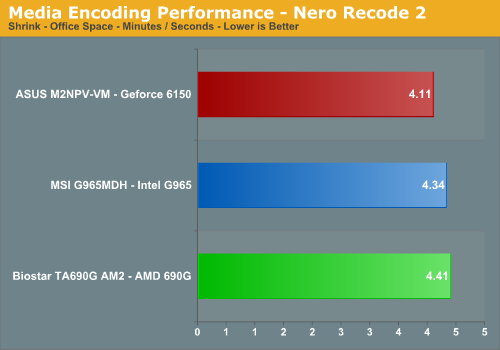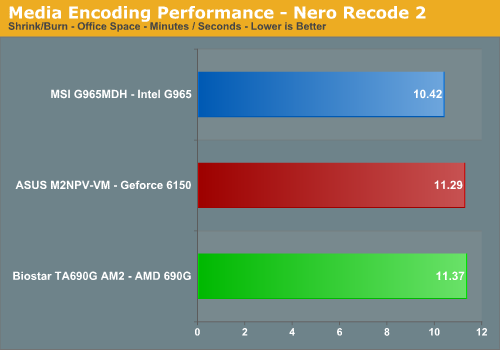Media Encoding Performance
A traditional weak spot of the current AM2 processor offerings has been in the media encoding arena when compared to the Intel Core 2 Duo. Considering the main optimizations for the Core 2 Duo centered on overall media encoding performance, we were very interested in seeing how this platform compared to current AMD lineups. We are utilizing an updated video encoding test suite for this article that includes AnyDVD, Nero Recode 2, Windows Media Encoder 9, and QuickTime Pro 7.1.
Our first series of tests is quite easy - we take our original Office Space DVD and use AnyDVD and Nero Recode 2 to copy the full DVD to the hard drive without compression, thus providing an almost exact duplicate of the DVD. We then fired up Nero Recode 2, selected our Office Space copy on the hard drive, and performed a shrink operation to allow the entire movie along with extras to fit on a single 4.5GB DVD disc. We then go back and use Nero Recode to shrink the full DVD copy and burn it onto our DVD disc. We left all options on their defaults except we checked off the advanced analysis option. The scores reported include the full encoding process and are represented in minutes/seconds, with lower numbers indicating better performance.



The results are very interesting as we did not expect our AM2 systems to perform this well and to do so is very surprising when reviewing other media encoding results. In fact, we ran the test several times and verified our settings before accepting the test results. Perhaps the last few months of Core 2 Duo results constantly exceeding AM2's best by a wide margin have tainted our cognitive abilities.
Of course, we are using a mid-range AM2 processor against the budget C2D part (the AMD price cuts have helped matters there, as the price difference is currently only about $35) but we fully believe the majority of the performance difference lies in the chipset selection on the AM2 systems. It is only in the shrink and burn tests that we see the Intel platform flexing its muscles. The difference in the shrink portion of this test was minimal and mirrored our individual shrink test results. We noticed our Intel platform was able to feed data to our DVD drive in a consistent manner with each of the AM2 platforms suffering from stutters several times resulting in our drive slowing down during the burn process. It was difficult to figure out if this was a driver, disk controller, or CPU issue. We are still testing on other chipset and CPU combinations.
Our next test has us converting our day at the beach AVI file into a high definition WMV file suitable for our Aunt Gertrude to view on her new high definition LCD TV. We ensured our quality settings were set for High Definition output. The remaining options are left at default values and then we let this program do its magic. We are reporting the numbers in minutes/seconds to complete the conversion.

These results left our heads shaking and we busily scurried off to the far corners of the lab looking for answers. After several test repeats, a few new images, and a couple of drinks, we stand by the results. Our answer, which we came up with after we switched out the MSI G965 board for a Gigabyte G965 board and had the same results, is that our E6300 is just incapable of keeping up with our AM2 5200+ X2 in this test. Why? It's all about the cache and CPU speed. Our E6600 trounces the 5200+ X2 at stock speeds and scores near it when running at E6300 speeds thanks to the increased cache. Meanwhile, our E6400 is just slightly off the 5200+ X2 pace at a modest 300MHz increase in speed over the E6300.
Next on the list is our QuickTime Pro 7.1 test that will convert our newly downloaded .Mov file into a plasma screen pleasing H.264 format. We ensured our quality settings were set to their highest levels and then let the horses loose. The values reported are again in minutes/seconds for the conversion time, with lower numbers being better.

Once again, the AM2 platforms have a slight advantage with the 6150 scoring outside of the norm in this test - so far outside that we thought something was not kosher in the land of NVIDIA. Fortunately for us, the answer was easy once we reviewed the playback files. It seems as though the quality of our encoding results on the NVIDIA platform left much to be desired along with numerous frames missing during playback or other frames just tangled together at times. We ran this same test under XP without an issue so our first blip with Vista has now occurred. Our video images are presented below.
In these particular screen shots both the G965 and 690G image quality results are basically even, but the 6150 is showing a case of the jaggies at full screen resolution. The entire playback file suffered from this issue.
A traditional weak spot of the current AM2 processor offerings has been in the media encoding arena when compared to the Intel Core 2 Duo. Considering the main optimizations for the Core 2 Duo centered on overall media encoding performance, we were very interested in seeing how this platform compared to current AMD lineups. We are utilizing an updated video encoding test suite for this article that includes AnyDVD, Nero Recode 2, Windows Media Encoder 9, and QuickTime Pro 7.1.
Our first series of tests is quite easy - we take our original Office Space DVD and use AnyDVD and Nero Recode 2 to copy the full DVD to the hard drive without compression, thus providing an almost exact duplicate of the DVD. We then fired up Nero Recode 2, selected our Office Space copy on the hard drive, and performed a shrink operation to allow the entire movie along with extras to fit on a single 4.5GB DVD disc. We then go back and use Nero Recode to shrink the full DVD copy and burn it onto our DVD disc. We left all options on their defaults except we checked off the advanced analysis option. The scores reported include the full encoding process and are represented in minutes/seconds, with lower numbers indicating better performance.



The results are very interesting as we did not expect our AM2 systems to perform this well and to do so is very surprising when reviewing other media encoding results. In fact, we ran the test several times and verified our settings before accepting the test results. Perhaps the last few months of Core 2 Duo results constantly exceeding AM2's best by a wide margin have tainted our cognitive abilities.
Of course, we are using a mid-range AM2 processor against the budget C2D part (the AMD price cuts have helped matters there, as the price difference is currently only about $35) but we fully believe the majority of the performance difference lies in the chipset selection on the AM2 systems. It is only in the shrink and burn tests that we see the Intel platform flexing its muscles. The difference in the shrink portion of this test was minimal and mirrored our individual shrink test results. We noticed our Intel platform was able to feed data to our DVD drive in a consistent manner with each of the AM2 platforms suffering from stutters several times resulting in our drive slowing down during the burn process. It was difficult to figure out if this was a driver, disk controller, or CPU issue. We are still testing on other chipset and CPU combinations.
Our next test has us converting our day at the beach AVI file into a high definition WMV file suitable for our Aunt Gertrude to view on her new high definition LCD TV. We ensured our quality settings were set for High Definition output. The remaining options are left at default values and then we let this program do its magic. We are reporting the numbers in minutes/seconds to complete the conversion.

These results left our heads shaking and we busily scurried off to the far corners of the lab looking for answers. After several test repeats, a few new images, and a couple of drinks, we stand by the results. Our answer, which we came up with after we switched out the MSI G965 board for a Gigabyte G965 board and had the same results, is that our E6300 is just incapable of keeping up with our AM2 5200+ X2 in this test. Why? It's all about the cache and CPU speed. Our E6600 trounces the 5200+ X2 at stock speeds and scores near it when running at E6300 speeds thanks to the increased cache. Meanwhile, our E6400 is just slightly off the 5200+ X2 pace at a modest 300MHz increase in speed over the E6300.
Next on the list is our QuickTime Pro 7.1 test that will convert our newly downloaded .Mov file into a plasma screen pleasing H.264 format. We ensured our quality settings were set to their highest levels and then let the horses loose. The values reported are again in minutes/seconds for the conversion time, with lower numbers being better.

Once again, the AM2 platforms have a slight advantage with the 6150 scoring outside of the norm in this test - so far outside that we thought something was not kosher in the land of NVIDIA. Fortunately for us, the answer was easy once we reviewed the playback files. It seems as though the quality of our encoding results on the NVIDIA platform left much to be desired along with numerous frames missing during playback or other frames just tangled together at times. We ran this same test under XP without an issue so our first blip with Vista has now occurred. Our video images are presented below.
 690G - Click to enlarge |
 G965 - Click to enlarge |
 6150 - Click to enlarge |
In these particular screen shots both the G965 and 690G image quality results are basically even, but the 6150 is showing a case of the jaggies at full screen resolution. The entire playback file suffered from this issue.










70 Comments
View All Comments
3 CUBED - Friday, March 9, 2007 - link
I have to mention power also. Considering that a HTPC is properly going to be on quiet a bit, I would like to se some info on the power draw, from these mobo's. The same goes in the roundup!! Also considering that the energy prices is headed only UP, even a little lower performance might be worth that in the long run!!Thanks Kasper.
MrNeutrino - Thursday, March 8, 2007 - link
Guys,First, the feedback:
Frankly I'm quite frustrated from waiting for a site like AT for the past half a year or more to come out with more mATX reviews (until this review, which is a start).
I realize there are a lot of gamers OCers out there - very many AT readers. However, there are many (just as many?) non-gamer enthusiasts hoping to run stock-speed,SILENT, SFF systems out there - myself for one.
While lesser known sites have reviewed many of these products, I (and others like me I know of) have been waiting for AT to publish SOMETHING in the mATX / C2D (current and long-standing performance champ depending on the system config.) category for months on end! I realize you have dedicated folks working for each review category. However, AT - a site as a whole - still seems to have enough bandwidth to publish back-to-back LCD and heatsink reviews in a matter of day or two each. Yet you seem to have held off on prioritizing mATX system reviews for some inexplicable milestone until yesterday. I recall reading a vague comment in one of your reviews around the end of the year regarding an 'upcoming' mATX review, if I remember correctly. In my opinion it was already too delayed a review. Little did I know I'd be waiting another two months for such a review.
Geez! Publish the review in parts if you must, but don't make your readers hold off for this long and think all is well! What's the point of releasing this type of review, months after products became widely available and just a few months before the next round of technology updates?!
-----------------------
Second is a set of requests for the (personally) much anticipated upcoming mATX review next week 'as well as' for future reviews:
Requests for the upcoming mATX review:
* Please try to include Asus P5B-VM. One of the currently best featured G965 MBs.
* Please include at least one C2D ATX MB for comparison! My vote is for Asus P5B-E. I can't stress this enough! I have yet to receive any 'quantitative' (read: benchmark backed) response in forums http://forums.anandtech.com/messageview.aspx?catid...">here) and http://forums.anandtech.com/messageview.aspx?catid...">here, on the following topics (quoting from my earlier posts):
- how do mATX boards compare to ATX boards "for non-gaming tasks such as video / audio editing, general productivity, multi-tasking etc.?"
- "How much of a performance hit does a G965 type mATX motherboard with integrated graphics incur as a result of sharing memory bus bandwidth with the CPU, for NON-GAMING benchmarks, compared to regular C2D ATX boards?" (Assuming of course, the user chooses to use integrated graphics vs. discrete solution and has that enabled in BIOS.)
Please BE SURE to adderss these and other such real-world topics and help make the review more meaningful for folks like me.
Requests for future reviews:
* Consider investing more time and effort in SFF / mATX / silent PC config based reviews! Yes, there is an audience out there...
* For a site this major and popular - both with readers and vendors - you need to seriously evaluate your time-to-publishing lags for some of these reviews - C2D mATX roundup review for one. I realize there are a million things you can review and only 24 hours in a day. Delayed reviews (compared to when the products came out) don't help your readers as much - think luxury car depreciation over time... :)
Thanks.
Gary Key - Thursday, March 8, 2007 - link
Hi,Your suggestions and comments are appreciated. I did reply in the forums this morning.
:)
MrNeutrino - Friday, March 9, 2007 - link
Thanks Gary.I appreciate you reviewing the feedback and requests in detail. Hopefully we'll see some follow-up action based on this as and where appropriate.
Also, thanks for replying to some of the key questions I've had around mATX vs. ATX boards. Lack of major performance delta is very good to hear about, at least for pre-Vista Windows OSes. Interesting.
Based on your comments in the forum posting re: Vista + IGP + memory latency, I am intrigued. If you are going to cover this in the upcoming review, feel free to say so and defer this question. Else I am curious what performance difference we are talking about between XP vs. Vista using IGP solutions? Any pointers to help with this comparison would be helpful in helping decide whether or not a Vista purchase is worthwhile from a performance standpoint in such categories / applications.
Also, have you transitioned to exclusively testing using Vista?
blawck - Wednesday, March 7, 2007 - link
I'm buying a small-form-factor PC with an Intel 965G motherboard (it was the only option), and I'm plugging in an NVIDIA 8800GTX video card. So, I was wondering how these IGP motherboards (specifically this Intel one) perform in general with a vidcard plugged in. Is performance on par with (or at least somewhere close to) that of full-size motherboards? Or am I getting screwed?Gary Key - Wednesday, March 7, 2007 - link
It depends on the board that you buy. The Gigabyte GA-965G-DS3 allows for a decent level of overclocking (330FSB) and memory options (CAS 3 operation), the overall performance difference will not be noticeable in day to day activities when compared to a more enthusiast level board. A base G965 board will not offer the same overclocking options and a couple of the boards only allow CAS 5 operation at DDR2-800, but once again, the performance delta overall will be less than 5% in most cases, nothing to be concerned about especially given your choice of video cards.blawck - Wednesday, March 7, 2007 - link
Great, thanks for the quick reply! This is a high-quality site =). The manufacturer is Maingear, and the board they're using for my system is simply identified generically as "Intel 965G Express," but based on your response, I have faith that I am, indeed, not getting screwed =). I've built all my previous machines, but I'm getting old and fat and lazy, so I figured I'd spend a few hundred extra and have someone do it for me. Not too worried about SLI or overclocking at this point...I'll accept whatever resolution I can run Oblivion in, as long as I can run it. Thanx again.chucky2 - Wednesday, March 7, 2007 - link
For the mATX review, you should include results for the Abit Fatal1ty F-I90HD.It's basically the 690G version for Intel CPU's...and that'd allow a direct comparison between Conroe and AM2 CPU's as the chipset would be the same.
Just a thought...
Chuck
P.S. Plus, I'm sure there's a good amount of people that'd like to run Conroe on a cheap but good mATX, and the Abit Fatal1ty F-I90HD looks to be about the best option out right now for that (albiet in limited quantities so far...), just too bad it doesn't have onboard Firewire (at least I don't think it does, didn't list it on the spec page), because then it'd have like everything one could want...
Gary Key - Wednesday, March 7, 2007 - link
We should receive that board next week. I will do my best to include in it the roundup.chucky2 - Wednesday, March 7, 2007 - link
Awesome if you can Gary, Cool if you can't......March looks like the month of motherboard reviews... :)
Chuck